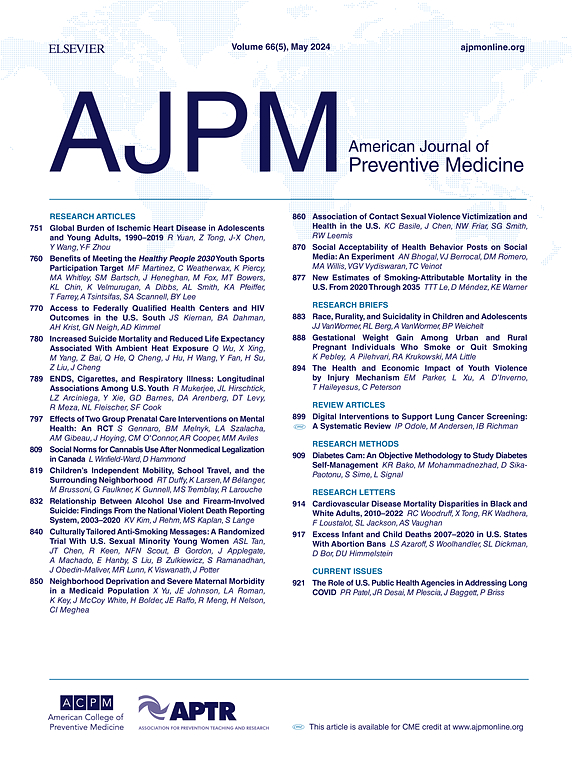Tobacco Spending Among Low-Income Older Adults in the United States, 2021–2023
IF 4.3
2区 医学
Q1 MEDICINE, GENERAL & INTERNAL
引用次数: 0
Abstract
Introduction
Spending on tobacco products may exacerbate health-related financial hardship experienced by low-income older adults. This study examined tobacco spending and the relationship between tobacco use and non-tobacco spending among low-income older adults in the U.S.
Methods
Using pooled 2021–2023 Consumer Expenditure Survey data, 1,983 single-person households (aged ≥65 years, with income <200% of the federal poverty level) were analyzed. Descriptive statistics summarized quarterly expenditures and budget shares for tobacco and nontobacco goods. Generalized linear and fractional logit models compared non-tobacco expenditures and budget shares between people who use (versus do not use) tobacco, controlling for sociodemographic covariates.
Results
Overall, 10.6% of respondents reported tobacco spending. Respondents who used tobacco spent an average of $305.0 (SD=303.4) per quarter on tobacco (7.8% of their total budget). Compared to respondents that did not use tobacco, respondents that used tobacco spent significantly more per quarter on alcohol ($54.8 vs $22.0, p<0.001) and significantly less per quarter on food ($783.9 vs $837.0, p<0.01), housing ($1,754.5 vs $2,189.7, p<0.05), health care ($564.0 vs $720.2, p<0.05), and clothing ($47.8 vs $64.7, p<0.05). Similarly, respondents that used tobacco spent a significantly greater portion of their budget on alcohol (1.3% vs 0.4%, p<0.001) and a significantly lower portion on food (19.6% vs 19.7%, p<0.05), housing (38.8% vs 43.4%, p<0.01), health care (14.7% vs 16.8%, p<0.01), and other expenses (2.0% vs 3.9%, p<0.01).
Conclusions
Tobacco spending and its complementary alcohol spending may reduce low-income older adults' expenditures on food, housing and health care.
2021-2023年美国低收入老年人的烟草消费
在烟草制品上的支出可能加剧低收入老年人所经历的与健康有关的经济困难。本研究调查了美国低收入老年人的烟草支出以及烟草使用与非烟草支出之间的关系。方法:使用汇总的2021-2023年消费者支出调查数据,1983个单身家庭(年龄≥65岁,有收入)。结果:总体而言,10.6%的受访者报告了烟草支出。使用烟草的受访者每季度平均花费305.0美元(SD = 303.4)用于烟草(占其总预算的7.8%)。与不使用烟草的受访者相比,使用烟草的受访者每个季度在酒精上的支出明显更多(54.8美元对22.0美元)。结论:烟草支出及其补充的酒精支出可能会减少低收入老年人在食品、住房和医疗保健方面的支出。
本文章由计算机程序翻译,如有差异,请以英文原文为准。
求助全文
约1分钟内获得全文
求助全文
来源期刊

American Journal of Preventive Medicine
医学-公共卫生、环境卫生与职业卫生
CiteScore
8.60
自引率
1.80%
发文量
395
审稿时长
32 days
期刊介绍:
The American Journal of Preventive Medicine is the official journal of the American College of Preventive Medicine and the Association for Prevention Teaching and Research. It publishes articles in the areas of prevention research, teaching, practice and policy. Original research is published on interventions aimed at the prevention of chronic and acute disease and the promotion of individual and community health.
Of particular emphasis are papers that address the primary and secondary prevention of important clinical, behavioral and public health issues such as injury and violence, infectious disease, women''s health, smoking, sedentary behaviors and physical activity, nutrition, diabetes, obesity, and substance use disorders. Papers also address educational initiatives aimed at improving the ability of health professionals to provide effective clinical prevention and public health services. Papers on health services research pertinent to prevention and public health are also published. The journal also publishes official policy statements from the two co-sponsoring organizations, review articles, media reviews, and editorials. Finally, the journal periodically publishes supplements and special theme issues devoted to areas of current interest to the prevention community.
 求助内容:
求助内容: 应助结果提醒方式:
应助结果提醒方式:


